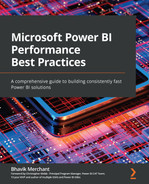Supercharge performance analytics and create repeatable patterns to ensure you get the best performance and scalability from your analytics solutions with Power BI This book comprehensively covers every layer of Power BI, from the report canvas to data modeling, transformations, storage, and architecture. Developers and architects working with any area of Power BI will be able to put their knowledge to work with this practical guide to design and implement at every stage of the analytics solution development process. This book is not only a unique collection of best practices and tips, but also provides you with a hands-on approach to identifying and fixing common performance issues. Complete with explanations of essential concepts and practical examples, you'll learn about common design choices that affect performance and consume more resources and how to avoid these problems. You'll grasp the general architectural issues and settings that broadly affect most solutions. As you progress, you'll walk through each layer of a typical Power BI solution, learning how to ensure your designs can handle scale while not sacrificing usability. You'll focus on the data layer and then work your way up to report design. We will also cover Power BI Premium and load testing. By the end of this Power BI book, you'll be able to confidently maintain well-performing Power BI solutions with reduced effort and know how to use freely available tools and a systematic process to monitor and diagnose performance problems. Data analysts, BI developers, and data professionals who have learnt the basics of Power BI and now want to understand how to build advanced analytics solutions will find this business intelligence book useful. Familiarity with the major components of Power BI and a beginner-level understanding of their purpose and use cases are required.Key Features
Book Description
What you will learn
Who this book is for
Table of Contents
- Microsoft Power BI Performance Best Practices
- Foreword
- Contributors
- About the author
- About the reviewers
- Preface
- Part 1: Architecture, Bottlenecks, and Performance Targets
- Chapter 1: Setting Targets and Identifying Problem Areas
- Chapter 2: Exploring Power BI Architecture and Configuration
- Chapter 3: DirectQuery Optimization
- Part 2: Performance Analysis, Improvement, and Management
- Chapter 4: Analyzing Logs and Metrics
- Chapter 5: Desktop Performance Analyzer
- Chapter 6: Third-Party Utilities
- Chapter 7: Governing with a Performance Framework
- Part 3: Fetching, Transforming, and Visualizing Data
- Chapter 8: Loading, Transforming, and Refreshing Data
- Chapter 9: Report and Dashboard Design
- Part 4: Data Models, Calculations, and Large Datasets
- Chapter 10: Data Modeling and Row-Level Security
- Chapter 11: Improving DAX
- Chapter 12: High-Scale Patterns
- Part 5: Optimizing Premium and Embedded Capacities
- Chapter 13: Optimizing Premium and Embedded Capacities
- Chapter 14: Embedding in Applications
- Other Books You May Enjoy
